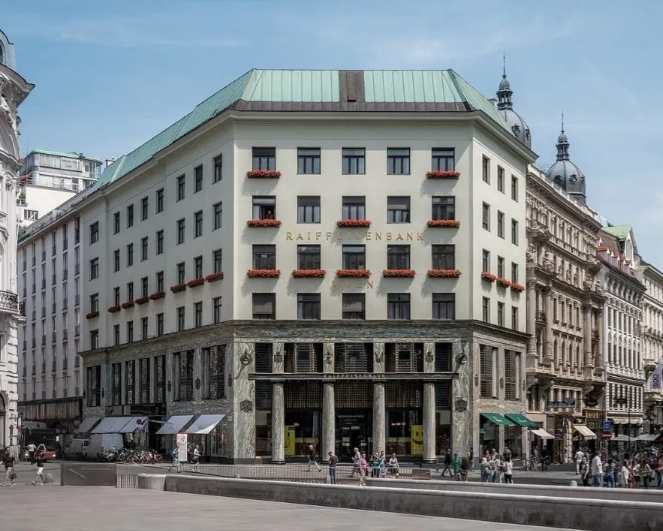Week 14 - How has early modernism influenced later exemples of Architecture
- t0414272
- Feb 24, 2024
- 5 min read
Introduction
The early modernist period is the beginning of modernity in art and design. During this period, all the artworks were a response to the historical, social and cultural situations. That being said, it is a movement that had an influence in the world of architecture. That's the reason why in this blog, I am going to analyse and discuss how early modernist architecture influenced later examples of architecture.
My primary example is the Steiner House made by Adolf Loss in (1910)
Image 1 - Adolf Loos (1910), Steiner House
Shape: The house has a cubic symmetrical shape with a curved roof.
Structure: With its cubic shape, the house has no type of ornamentations on the facades, we can only see glass windows. However, the back of the building is different to the front as the middle part is backward shifted and not on the same level as the left and side parts.
Materials: It is made with materials like sheet metal, cement, bricks and timber.
Colour: The house only present simple black and white shades. The house is entirely painted in white and the roof is black. (WikiArquitectura, n.d)
Pattern: The house do not present any type of ornamentation on the facades. So, we can not see any type of patterns.
Biography
Adolf Loos is an Austrian architect who was at first studying mechanic at the Royal and Imperial State Technical College before abandoning this field to study building technology at State Crafts School to drop again and pursue with Architectural studies at Dresden University of Technology. (Craven J. , 2019)
He was one of the most influential architects that believed that functionality and simplicity are over beauty, so, over ornamentation. (Rawn E. , 2019)
Loos is a famous architect of the modernist period that produced a lot of different works focusing on simplification of shapes and colours for building's facades (see image 4 and 5)
Image 2 - Adolf Loos (1909), The Loos Haus
Image 3 - Adolf Loos (1929), Villa Muller
The movement: Early modernism
It is a movement that started from the middle of the 20th century to the end of it with art movements such as Arts and Crafts Movements, Art Nouveau and Art Deco
It has been marked by the exploration of new technologies, building techniques and construction materials (Visual Arts Corks, n.d) from the industry.
Functionality was a main aspect of this architectural style with vernacular or polite style and a use of materials such as iron, steel, glass and concrete (Visual Arts Corks, n.d)
Glass Construction represented the subsequent society (Spurr D., 2012)
Wider context: Industrial Revolution
Changes with technology during the industrial revolution that changed the society by bringing different manners of living and working (Britannica, 2024)
It allowed to encounter an ease of transportation and resources that were coming from industries (Viollet-le-Duc, 1958) to change the society.
The Industrial revolution influenced a lot the works that were produced in the early modernist period as the use of iron, steel, glass and components was being widespread. (Muffet J. , n.d)
How this period is influencing architecture
Image 4 - Mies Van Der Rohe (1963), Neue Nationalgalerie
This building in image 4 is the new version after the renovation of the Neue Nationalgalerie.
It takes its influence from the early modernist period with the steel and glass that represent the materials of the structure. By the materials used, it reminds of the Steiner House.
The roof is made with steel and the glass is going from the floor to the ceiling. It is also allowing a variety of possibilities with regard to the use of space. (ArchDaily, 2021)
Image 5 - JM Architecture (2022), Pinwheel House
It is linked to early modernist period by its simple symmetrical shape and its all white colour.
The simple shapes and colours present the same characteristics as the Steiner House and so, create a link between these two examples.
There is no decoration from the outside of the house as in early modernist period where architects were against decoration.
Image 6 - Odile Decq (2006), Experimental Glass House
The house is entirely made with glass and steel, a material that was explored with the industrial revolution that helped the early modernist period in architecture.
It is also made with Steel, but it is hidden by the glass to not break the "all glass" concept. (Frearson A, 2022)
This house also make a priority to the functionality, a characteristic of early modernism architecture as it is made for a client that have vision damage. (Frearson A, 2022)
The black and white colour with the glass relates also to the Steiner house as they are the characteristics that they have in common.
Image 7 - Antti Lovag (2010), Maison Bernard
Maison Bernard is a colourful house with and organic shape.
It can be linked to early modernist architecture and specifically the Art Nouveau period because of the organic shape.
It is made with sprayed concrete and steel rod, and made with a combination of new building technologies (Stech A. n,d) as in the early modernist period where new materials and technics were explored
I can see a link between the organic and curved shape of the Maison Bernard and the curvy roof of the Steiner House.
Image 8 - Zaha Hadid (2019), Al Janoub Stadium
This Stadium is obviously presenting curvy shapes and decorative patterns.
It has been influenced by the early modernist period and specifically Art Nouveau period by the curvy or organic shapes and the Art Deco period because of the decoration that are on it. (see image 9)
By looking at the Steiner House, they have the same characteristics with regards to the use of curvy shapes with the roof for the Steiner House.
Image 9 - Zaha Hadid (2019), Al Janoub Stadium, close-up
Conclusion
To summarize, it is important to bare in mind that the most important event that happened during the early modernist period is the Industrial Revolution. This industrialisation helped architects to explore different technics of constructions and materials for their architectural projects. This period is an important one that had a lot of impact, until these days, in architecture.
Image list
Image 1 - Adolf Loos (1910), Steiner House
Image 2 - Adolf Loos (1909), The Loos Haus
Image 3 - Adolf Loos (1929), Villa Muller
Image 4 - Mies Van Der Rohe (1963), Neue Nationalgalerie
Image 5 - JM Architecture (2022), Pinwheel House
Image 6 - Odile Decq (2006), Experimental Glass House
Image 7 - Antti Lovag (2010), Maison Bernard
Image 8 - Zaha Hadid (2019), Al Janoub Stadium
Image 9 - Zaha Hadid (2019), Al Janoub Stadium, close-up
Reference list
Adolf Loss (1910) Steiner House [House] Vienna, Austria
WikiArquitectura (n.d) Steiner House. Retrieved from: https://en.wikiarquitectura.com/building/steiner-house/ [Accessed 22 February 2024]
Craven J. (2019) Biography of Adolf Loos, Belle Epoque Architect and Rebel [Online] Retrieved from: https://www.thoughtco.com/adolf-loos-architect-of-no-ornamentation-177859 [Accessed 22 February 2024]
Rawn E. (2019) Spotlight: Adolf Loos [Online] Retrieved from: https://www.archdaily.com/576187/spotlight-adolf-loos [Accessed 22 February 2024]
Adolf Loos (1909), The Loos Haus [Office] Vienna, Austria
Adolf Loos (1929), Villa Muller [Villa] Prague, Czech Republic
Visual Arts Corks (n.d) 20th-Century Architecture [Online] Retrieved from: http://www.visual-arts-cork.com/architecture/twentieth-century.htm [Accessed 22 February 2024]
Spurr D. (2012). An End to Dwelling: Architectural and Literary Modernisms. University of Michigan Press : Ann Arbor
Britannica, T. Editors of Encyclopaedia (2024) Industrial Revolution. Encyclopedia Britannica. Retrieved from: https://human.libretexts.org/Bookshelves/Art/Introduction_To_Art_(Jones)/01%3A_Media_and_Techniques/1.11%3A_Modern_Architecture#:~:text=The%20Industrial%20Revolution%20introduced%20and,and%20plain%20or%20shiny%20surfaces. [Accessed 22 February 2024]
Pevsner N. (1968), The Sources of Modern Architecture and Design, London: Thames & Hudson
Muffet J. (n.d), Modern Architecture, [Online] Retrieved from: https://human.libretexts.org/Bookshelves/Art/Introduction_To_Art_(Jones)/01%3A_Media_and_Techniques/1.11%3A_Modern_Architecture#:~:text=The%20Industrial%20Revolution%20introduced%20and,and%20plain%20or%20shiny%20surfaces. [Accessed 22 February 2024]
Mies Van Der Rohe (1963) Neue Nationalgalerie [Galery] Berlin, Germany
ArchDaily (2021) Dornbratch,The Renovated Neue Nationalgalerie Utilizes Designs Retrieved from: https://www.archdaily.com/960296/the-renovated-neue-nationalgalerie-utilizes-designs-by-dornbracht [Accessed 22 February 2024]
JM Architecture (2022), Pinwheel House [House] Luino, Italy
Odile Decq (2006) Experimental Glass House [House] Carantec, France
Frearson A. (2022) Odile Decq builds all-glass Maison de Verre for client with vision loss. Retrieved from: https://www.dezeen.com/2022/11/07/odile-decq-house-maison-de-verre-translucent-glass/ [Accessed 23 February 2024]
Antti LOvag (2010) Maison Bernard [House] Theoule sur Mer, France
Stetch A. (n.d) Colour blast: Odile Decq renovates Antti Lovag's iconic Maison Bernard in France [Online] Retrieved from: https://www.wallpaper.com/architecture/residential/sunny-side-up-thiss-studio-london-uk [Accessed 23 February 2024]
Zaha Hadid (2019) Al Janoub Stadium [Stadium Sport] Al Wakrah, Qatar
















Comments